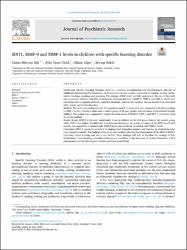| dc.contributor.author | Cansu Mercan Isik | |
| dc.contributor.author | Ayla Uzun Cicek | |
| dc.contributor.author | Dilara Ulger | |
| dc.contributor.author | Sevtap Bakir | |
| dc.date.accessioned | 2023-04-12T08:48:22Z | |
| dc.date.available | 2023-04-12T08:48:22Z | |
| dc.date.issued | 01.0.8.2022 | tr |
| dc.identifier.uri | https://www.sciencedirect.com/science/article/pii/S0022395622003120?via%3Dihub | |
| dc.identifier.uri | https://hdl.handle.net/20.500.12418/13639 | |
| dc.description.abstract | bstract
Background
Specific Learning Disorder (SLD) is a common developmental and neurobiological disorder of childhood characterized by impairment of functionality in one or more areas such as reading, writing, mathematics, listening, speaking, and reasoning. The etiology of SLD is still not fully understood. The aim of this study was to evaluate children with SLD to investigate the potential role of MMP-9, TIMP-1 and SIRT-1, which have important roles in synaptic plasticity, cognitive functions, learning and memory, and are known to be associated with various psychiatric disorders.
Methods
The study was conducted with 44 outpatients aged 8–14 years who were diagnosed with SLD according to DSM-5 in the outpatient clinic and a control group of 44 age, gender and education level-matched healthy children. The groups were compared in respect of serum levels of MMP-9, TIMP-1 and SIRT-1, evaluated using the ELISA method.
Results
Serum MMP-9 levels were significantly lower in children in the SLD group than in the control group, while TIMP-1 was higher. No difference was determined between the groups in respect of the SIRT1 levels. SLD severity was negatively correlated with MMP-9 levels and positively correlated with TIMP-1 levels.
Conclusions
MMP-9 appear to contribute to hippocampal-dependent memory and learning by modulating long-term synaptic plasticity. The findings of this study also reinforce the idea that deregulation of the MMP-9/TIMP-1 ratio may impact learning and play a role in SLD. These findings will help to elucidate the etiology of SLD. Furthermore, understanding molecular pathways can contribute to the discovery of certain biomarkers in SLD pathogenesis and the development of new treatment possibilities. | tr |
| dc.language.iso | eng | tr |
| dc.publisher | Elsevier | tr |
| dc.relation.isversionof | 10.1016/j.jpsychires.2022.06.015 | tr |
| dc.rights | info:eu-repo/semantics/openAccess | tr |
| dc.subject | Specific learning disorder (SLD)MMP-9Sirtuin-1 (SIRT-1)TelomeraseTIMP-1Child/adolescent | tr |
| dc.title | SIRT1, MMP-9 and TIMP-1 levels in children with specific learning disorder | tr |
| dc.type | article | tr |
| dc.relation.journal | Journal of Psychiatric Research | tr |
| dc.contributor.department | Rektörlüğe Bağlı İdari Birimler | tr |
| dc.contributor.authorID | 0000-0002-6834-020X | tr |
| dc.identifier.issue | 152 | tr |
| dc.identifier.endpage | 359 | tr |
| dc.identifier.startpage | 352 | tr |
| dc.relation.publicationcategory | Uluslararası Hakemli Dergide Makale - Kurum Öğretim Elemanı | tr |















